LTCC and Bulk Zn4B6O13–Zn2SiO4 Composites for Submillimeter Wave Applications
Abstract
:1. Introduction
2. Materials and Methods
3. Results and Discussion
3.1. Composition, Microstructure, Sintering Behavior
3.2. LTCC Structures
3.3. Dielectric Properties
4. Conclusions
- Lowering or broadening and stabilization of the sintering temperature range
- Improvement of the surface smoothness and uniformity of the substrates and consequently the quality and resolution of screen-printed patterns
- High-frequency dielectric constants for composites containing 10–15 wt% Zn2SiO4 are lower than those of the pure ceramic components
Author Contributions
Funding
Data Availability Statement
Conflicts of Interest
References
- Rappaport, T.S.; Sun, S.; Mayzus, R.; Zhao, H.; Azar, Y.; Wang, K.; Wong, G.N.; Schulz, J.K.; Samimi, M.; Gutierrez, F. Millimeter Wave Mobile Communications for 5G Cellular: It Will Work! IEEE Access 2013, 1, 335–349. [Google Scholar] [CrossRef]
- Muhammad, R.; Iqbal, Y.; Rambo, C.R.; Khan, H. Research trends in microwave dielectrics and factors affecting their properties: A review. Int. J. Mater. Res. 2014, 105, 431–439. [Google Scholar] [CrossRef]
- Sebastian, M.T.; Ubic, R.; Jantunen, H. Low-loss dielectric ceramic materials and their properties. Int. Mater. Rev. 2015, 60, 392–412. [Google Scholar] [CrossRef]
- Raveendran, A.; Sebastian, M.T.; Raman, S. Applications of Microwave Materials: A Review. J. Electron. Mater. 2019, 48, 2601–2634. [Google Scholar] [CrossRef] [Green Version]
- Li, L.; Liu, C.H.; Zhu, J.Y.; Chen, X.M. B2O3-modified fused silica microwave dielectric materials with ultra-low dielectric constant. J. Eur. Ceram. Soc. 2015, 35, 1799–1805. [Google Scholar] [CrossRef]
- Szwagierczak, D.; Synkiewicz, B.; Kulawik, J. Low dielectric constant composites based on B2O3 and SiO2 rich glasses, cordierite and mullite. Ceram. Int. 2018, 44, 14495–14501. [Google Scholar] [CrossRef]
- Varghese, J.; Ramachandran, P.; Sobocinski, M.; Vahera, T.; Jantunen, H. ULTCC Glass Composites Based on Rutile and Anatase with Cofiring at 400 °C for High Frequency Applications. ACS Sustain. Chem. Eng. 2019, 7, 4274–4283. [Google Scholar] [CrossRef]
- Tsunooka, T.; Ando, M.; Suzuki, S.; Yasufuku, Y.; Ohsato, H. Research & Developments for Millimeter-Wave Dielectric Forsterite with Low Dielectric Constant, High Q, and Zero Temperature Coefficient of Resonant Frequency. Jpn. J. Appl. Phys. 2013, 52, 9. [Google Scholar] [CrossRef]
- Bafrooei, H.B.; Liu, B.; Su, W.; Song, K.X. Ca3MgSi2O8: Novel low-permittivity microwave dielectric ceramics for 5G application. Mater. Lett. 2020, 263, 127248. [Google Scholar] [CrossRef]
- Lan, X.; Li, J.; Wang, F.; Wang, X.; Lu, W.; Hu, M.; Lei, W.; Wang, X. A novel low-permittivity LiAl0.98(Zn0.5Si0.5)0.02O2 -based microwave dielectric ceramics for LTCC application. Int. J. Appl. Ceram. Technol. 2019, 17, 745–750. [Google Scholar] [CrossRef]
- Guo, Y.; Ohsato, H.; Kakimoto, K.-I. Characterization and dielectric behavior of willemite and TiO2-doped willemite ceramics at millimeter-wave frequency. J. Eur. Ceram. Soc. 2006, 26, 1827–1830. [Google Scholar] [CrossRef]
- Dong, M.; Yue, Z.; Zhuang, H.; Meng, S.; Li, L. Microstructure and Microwave Dielectric Properties of TiO2-Doped Zn2SiO4 Ceramics Synthesized Through the Sol-Gel Process. J. Am. Ceram. Soc. 2008, 91, 3981–3985. [Google Scholar] [CrossRef]
- Kim, J.-S.; Song, M.-E.; Joung, M.-R.; Choi, J.-H.; Nahm, S.; Gu, S.-I.; Paik, J.-H.; Choi, B.-H. Effect of B2O3 addition on the sintering temperature and microwave dielectric properties of Zn2SiO4 ceramics. J. Eur. Ceram. Soc. 2010, 30, 375–379. [Google Scholar] [CrossRef]
- Nguyen, N.-H.; Lim, J.-B.; Nahm, S.; Paik, J.-H.; Kim, J.-H. Effect of Zn/Si Ratio on the Microstructural and Microwave Dielectric Properties of Zn2SiO4 Ceramics. J. Am. Ceram. Soc. 2007, 90, 3127–3130. [Google Scholar] [CrossRef]
- Kim, J.-S.; Nguyen, N.-H.; Lim, J.-B.; Paik, D.-S.; Nahm, S.; Paik, J.-H.; Kim, J.-H.; Lee, H.-J. Low-Temperature Sintering and Microwave Dielectric Properties of the Zn2SiO4 Ceramics. J. Am. Ceram. Soc. 2007, 91, 671–674. [Google Scholar] [CrossRef]
- Dou, G.; Zhou, D.; Guo, M.; Gong, S. Low-temperature sintered Zn2SiO4–CaTiO3 ceramics with near-zero temperature coefficient of resonant frequency. J. Alloy. Compd. 2012, 513, 466–473. [Google Scholar] [CrossRef]
- Nedelcu, L.; Geambasu, C.D.; Banciu, M.G.; Iwamae, A.; Furuya, T.; Tani, M. Submillimeter-wave properties of Zn2SiO4 ceramics. In Proceedings of the 40th International Conference on Infrared, Millimeter, and Terahertz waves (IRMMW-THz 2015), Hong Kong, China, 23–28 August 2015; pp. 23–28. [Google Scholar] [CrossRef]
- Dou, G.; Guo, M.; Li, Y.; Lin, J. Effects of low melting point materials on sinterability and microwave dielectric properties of X2SiO4–CaTiO3 (X = Mg, Zn) for LTCC. J. Mater. Sci. Mater. Electron. 2015, 26, 9195–9199. [Google Scholar] [CrossRef]
- Kim, S.; Yoon, S.O.; Kim, Y.H.; Jeong, S.M.; Park, H. Microstructure, phase evolution and microwave dielectric properties of Li2O and Ga2O3 doped zinc orthosilicate. Ceram. Silikaty 2017, 61, 209–213. [Google Scholar] [CrossRef] [Green Version]
- Weng, Z.; Song, C.; Xiong, Z.; Xue, H.; Sun, W.; Zhang, Y.; Yang, B.; Reece, M.J.; Yan, H. Microstructure and broadband dielectric properties of Zn2SiO4 ceramics with nano-sized TiO2 addition. Ceram. Int. 2019, 45, 13251–13256. [Google Scholar] [CrossRef]
- Weng, Z.; Guan, R.; Xiong, Z. Effects of the ZBS addition on the sintering behavior and microwave dielectric properties of 0.95Zn2SiO4-0.05CaTiO3 ceramics. J. Alloy. Compd. 2017, 695, 3517–3521. [Google Scholar] [CrossRef]
- Hu, X.; Huang, X.; Chen, Y.; Li, Y.; Ling, Z. Phase evolution and microwave dielectric properties of SrTiO3 added ZnAl2O4-Zn2SiO4-SiO2 ceramics. Ceram. Int. 2020, 46, 7050–7054. [Google Scholar] [CrossRef]
- Synkiewicz-Musialska, B.; Szwagierczak, D.; Kulawik, J.; Pałka, N.; Bajurko, P. Impact of additives and processing on microstructure and dielectric properties of willemite ceramics for LTCC terahertz applications. J. Eur. Ceram. Soc. 2020, 40, 362–370. [Google Scholar] [CrossRef]
- Chaware, V.; Deshmukh, R.; Sarode, C.; Gokhale, S.; Phatak, G. Low-Temperature Sintering and Microwave Dielectric Properties of Zn2SiO4 Ceramic Added with Crystalline Zinc Borate. J. Electron. Mater. 2015, 44, 2312–2320. [Google Scholar] [CrossRef]
- Jiang, X.; Molokeev, M.S.; Gong, P.; Yang, Y.; Wang, W.; Wang, S.; Wu, S.; Wang, Y.; Huang, R.; Li, L.; et al. Near-Zero Thermal Expansion and High Ultraviolet Transparency in a Borate Crystal of Zn4B6O13. Adv. Mater. 2016, 28, 7936–7940. [Google Scholar] [CrossRef] [PubMed]
- Szwagierczak, D.; Synkiewicz-Musialska, B.; Kulawik, J.; Czerwińska, E.; Pałka, N.; Bajurko, P. Low temperature sintering of Zn4B6O13 based substrates, their microstructure and dielectric properties up to the THz range. J. Alloy. Compd. 2020, 819, 153025. [Google Scholar] [CrossRef]
- Yu, H.; Ju, K.; Wang, K. A Novel Glass-Ceramic with Ultra-Low Sintering Temperature for LTCC Application. J. Am. Ceram. Soc. 2014, 97, 704–707. [Google Scholar] [CrossRef]
- Ju, K.; Yu, H.; Ye, L.; Xu, G. Ultra-Low Temperature Sintering and Dielectric Properties of SiO2-Filled Glass Composites. J. Am. Ceram. Soc. 2013, 96, 3563–3568. [Google Scholar] [CrossRef]
- Wu, X.-G.; Wang, H.; Chen, Y.-H.; Zhou, D. Synthesis and Microwave Dielectric Properties of Zn3B2O6 Ceramics for Substrate Application. J. Am. Ceram. Soc. 2012, 95, 1793–1795. [Google Scholar] [CrossRef]
- Zhou, D.; Pang, L.-X.; Wang, D.-W.; Qi, Z.-M.; Reaney, I.M. High Quality Factor, Ultralow Sintering Temperature Li6B4O9 Microwave Dielectric Ceramics with Ultralow Density for Antenna Substrates. ACS Sustain. Chem. Eng. 2018, 6, 11138–11143. [Google Scholar] [CrossRef] [Green Version]
- Sasidharanpillai, A.; Kim, C.H.; Lee, C.H.; Sebastian, M.T.; Kim, H.T. Environmental Friendly Approach for the Development of Ultra-Low-Firing Li2WO4 Ceramic Tapes. ACS Sustain. Chem. Eng. 2018, 6, 6849–6855. [Google Scholar] [CrossRef]
- Yin, C.; Li, C.; Yang, G.; Fang, L.; Yuan, Y.; Shu, L.; Khaliq, J. NaCa4V5O17: A low-firing microwave dielectric ceramic with low permittivity and chemical compatibility with silver for LTCC applications. J. Eur. Ceram. Soc. 2020, 40, 386–390. [Google Scholar] [CrossRef]
- Oliveira, R.; Silva, R.; De Morais, J.; Batista, G.; Silva, M.; Goes, J.; De Andrade, H.; Júnior, I.Q.; Singh, C.; Sombra, A. Effects of CaTiO3 addition on the microwave dielectric properties and antenna properties of BiVO4 ceramics. Compos. Part B Eng. 2019, 175, 107122. [Google Scholar] [CrossRef]
- Joseph, N.; Varghese, J.; Teirikangas, M.; Sebastian, M.T.; Jantunen, H. Ultra-low sintering temperature ceramic composites of CuMoO4 through Ag2O addition for microwave applications. Compos. Part B Eng. 2018, 141, 214–220. [Google Scholar] [CrossRef]
- Faouri, S.S.; Mostaed, A.; Dean, J.S.; Wang, D.; Sinclair, D.C.; Zhang, S.; Whittow, W.G.; Vardaxoglou, Y.; Reaney, I.M. High quality factor cold sintered Li2MoO4BaFe12O19 composites for microwave applications. Acta Mater. 2019, 166, 202–207. [Google Scholar] [CrossRef] [Green Version]
- Wang, D.; Zhang, S.; Wang, G.; Vardaxoglou, Y.; Whittow, W.; Cadman, D.; Zhou, D.; Song, K.; Reaney, I.M. Cold sintered CaTiO3-K2MoO4 microwave dielectric ceramics for integrated microstrip patch antennas. Appl. Mater. Today 2020, 18, 100519. [Google Scholar] [CrossRef]
- Lv, Y.; Zhou, W.; Dong, Z.; Yuan, S.; Ding, X.; Ma, T.; Cui, S. Influence of CaO-B2O3-SiO2 crystallizable glass on microstructure and microwave dielectric of LiMg0.9Zn0.1PO4 ceramics for LTCC substrate applications. J. Alloy Compd. 2020, 844, 156212. [Google Scholar] [CrossRef]
- Xiang, H.; Kilpijärvi, J.; Myllymäki, S.; Yang, H.; Fang, L.; Jantunen, H. Spinel-olivine microwave dielectric ceramics with low sintering temperature and high quality factor for 5 GHz wi-fi antennas. Appl. Mater. Today 2020, 21, 100826. [Google Scholar] [CrossRef]
- Eldem, M.A.; Orton, B.R.; Whitaker, A. Phase equilibria in the system ZnO-B2O3-SiO2 at 950 °C. J. Mater. Sci. 1987, 22, 4139–4143. [Google Scholar] [CrossRef]
- Kamba, S.; Petzelt, J.; Buixaderas, E.; Haubrich, D.; Vanek, P.; Kuzel, P.; Jawahar, I.N.; Sebastian, M.T.; Mohanan, P. High frequency dielectric properties of A5B4O15 microwave ceramics. J. Appl. Phys. 2001, 89, 3900–3906. [Google Scholar] [CrossRef]
- Zheng, C.W.; Fan, X.C.; Chen, X.M. Analysis of Infrared Reflection Spectra of (Mg1-xZnx)Al2O4 Microwave Dielectric Ceramics. J. Am. Ceram. Soc. 2008, 91, 490–493. [Google Scholar] [CrossRef]
- Kim, E.S.; Chun, B.S.; Freer, R.; Cernik, R.J. Effects of packing fraction and bond valence on microwave dielectric properties of A2+B6+O4 (A2+: Ca, Pb, Ba; B6+: Mo, W) ceramics. J. Eur. Ceram. Soc. 2010, 30, 1731–1736. [Google Scholar] [CrossRef]
- Li, J.; Han, Y.; Qiu, T.; Jin, C. Effect of bond valence on microwave dielectric properties of (1 − x)CaTiO3-x(Li0.5La0.5)TiO3 ceramics. Mater. Res. Bull. 2012, 47, 2375–2379. [Google Scholar] [CrossRef]
- Tang, Y.; Zhang, Z.; Li, J.; Xu, M.; Zhai, Y.; Duan, L.; Su, C.; Liu, L.; Sun, Y.; Fang, L. A3Y2Ge3O12 (A = Ca, Mg): Two novel microwave dielectric ceramics with contrasting τf and Q × f. J. Eur. Ceram. Soc. 2020, 40, 3989–3995. [Google Scholar] [CrossRef]
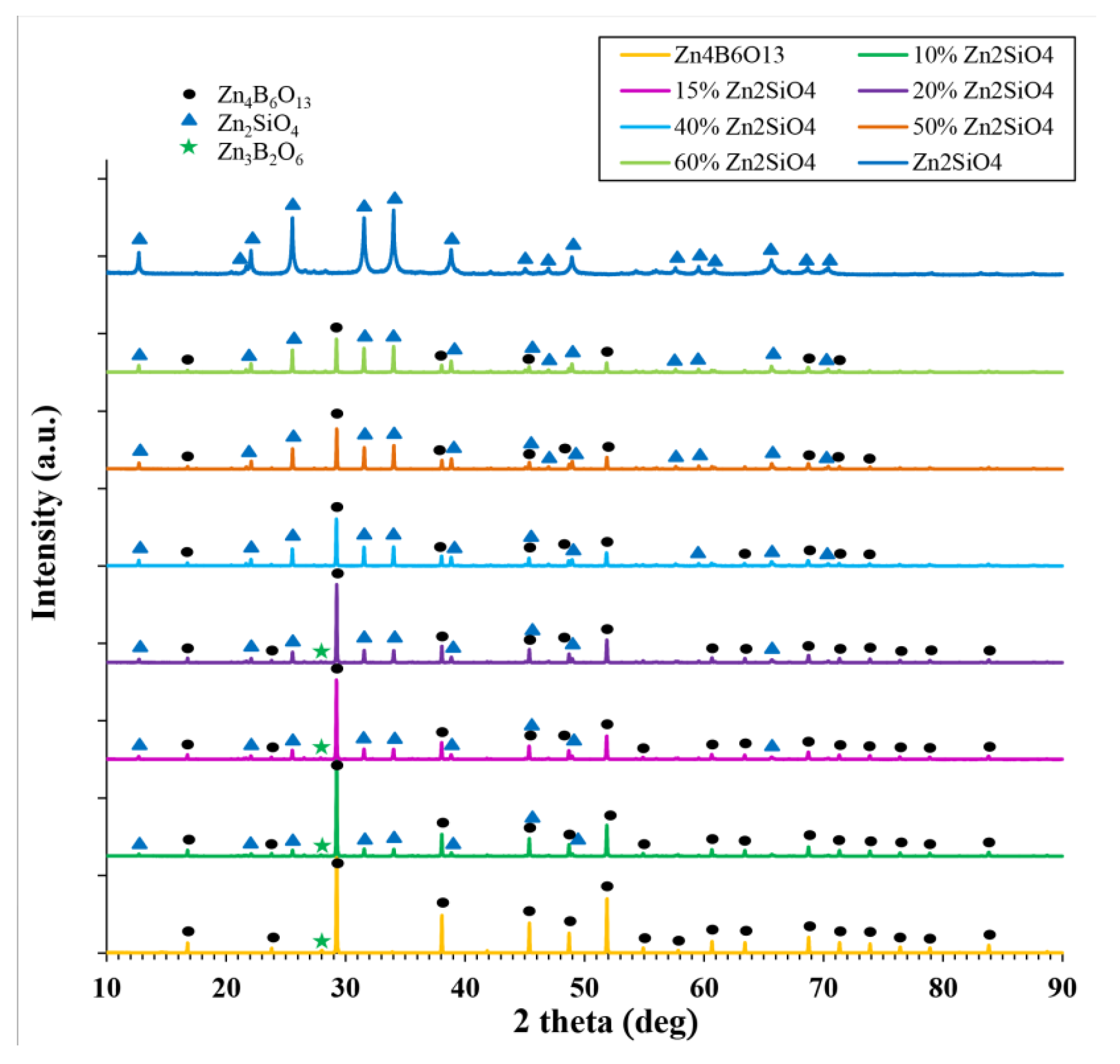
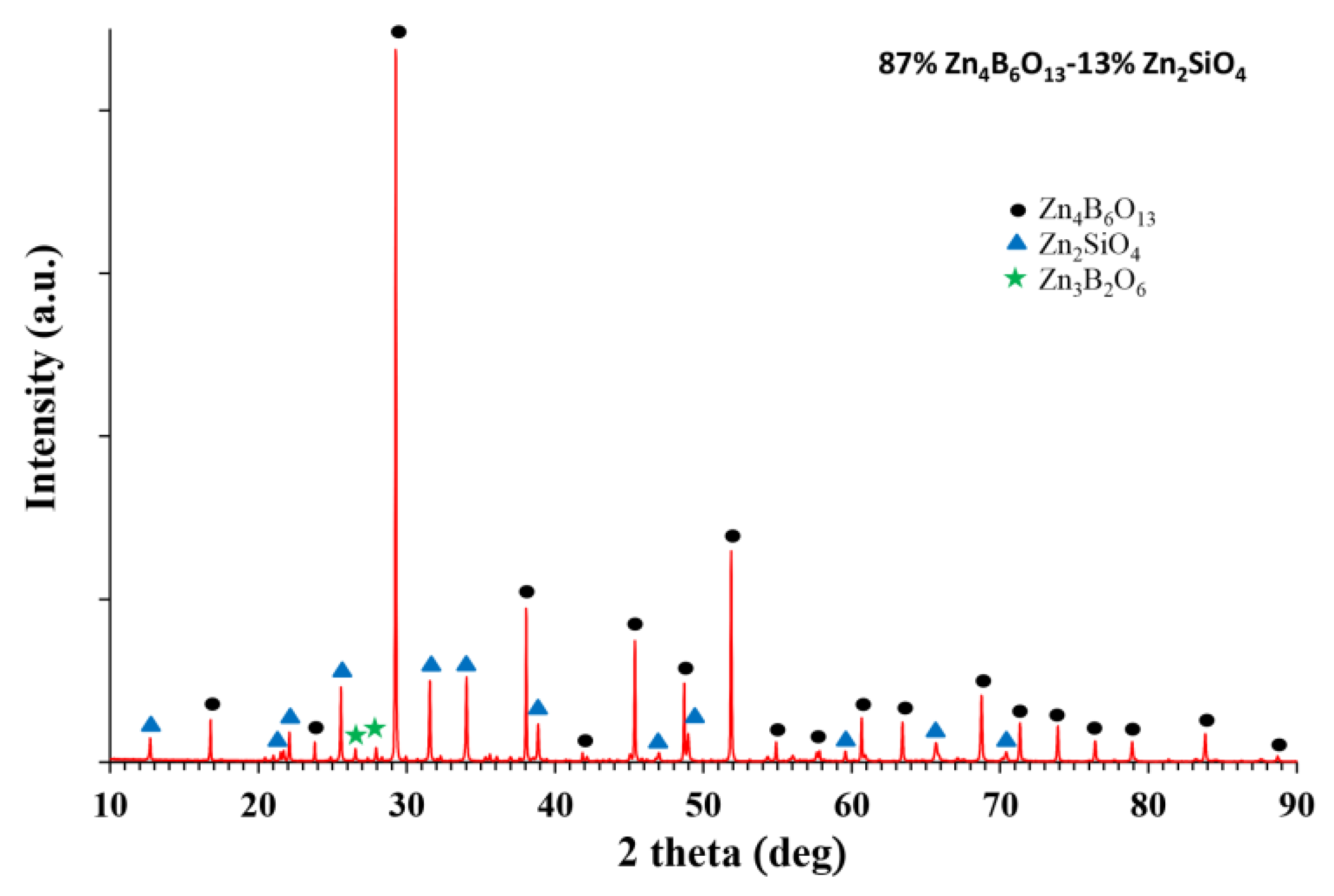
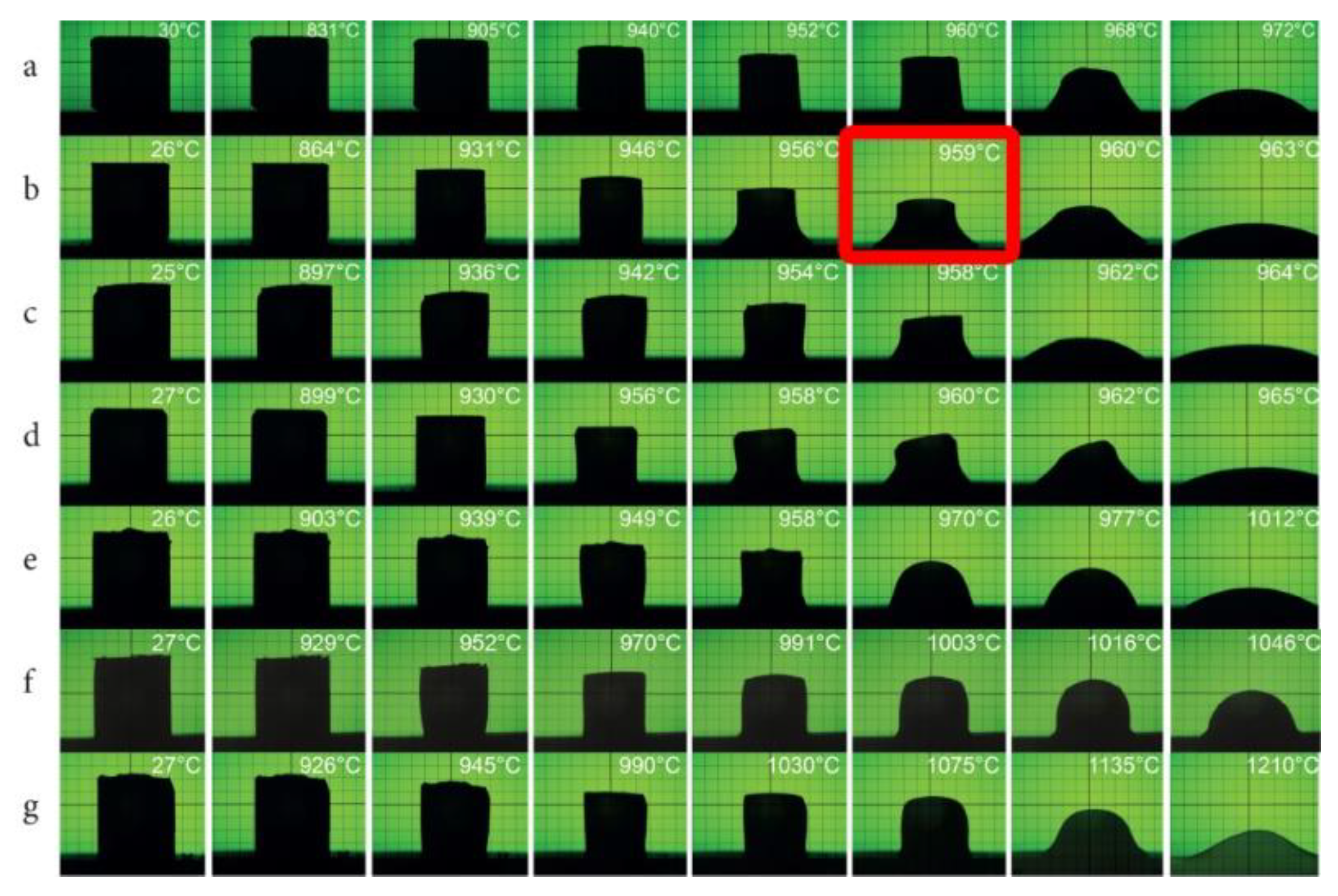
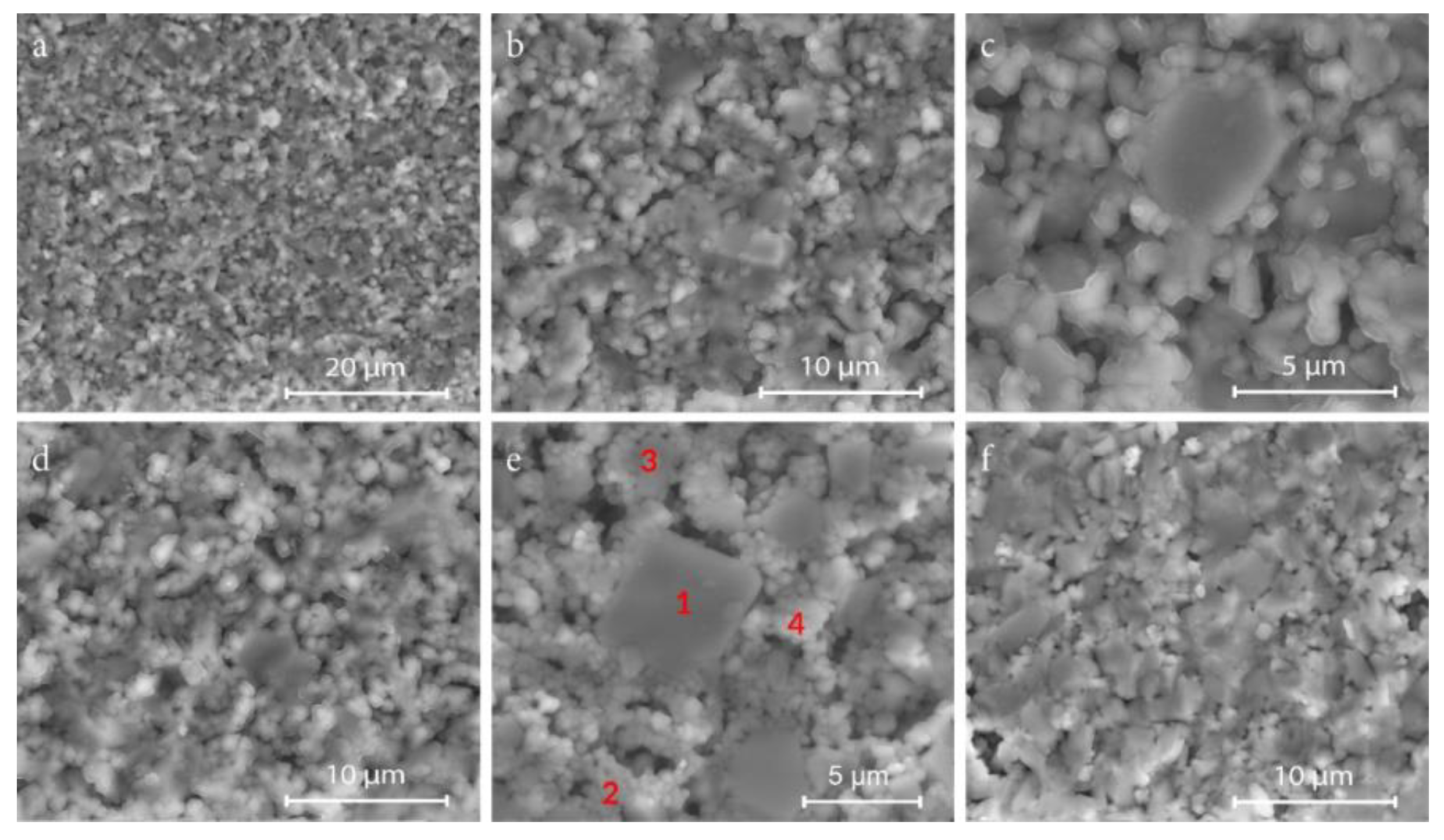

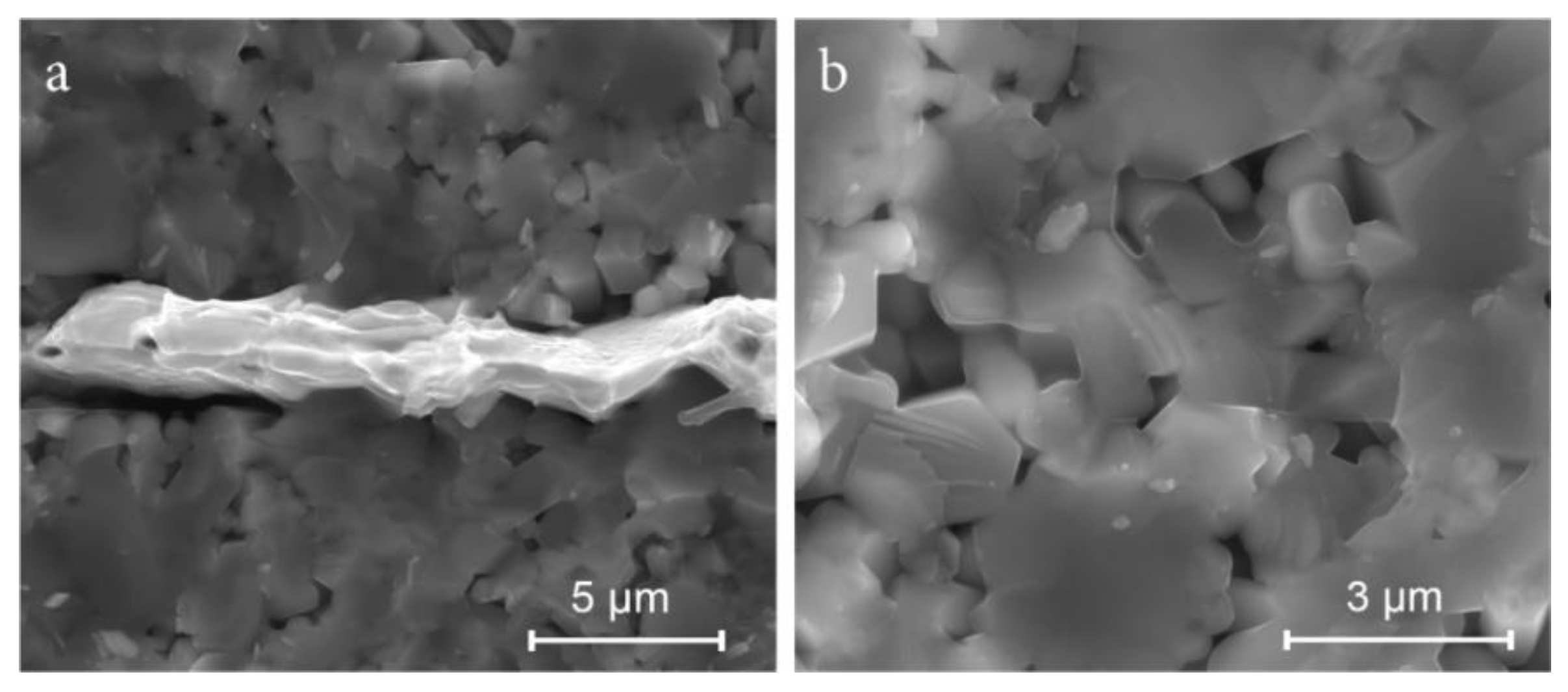
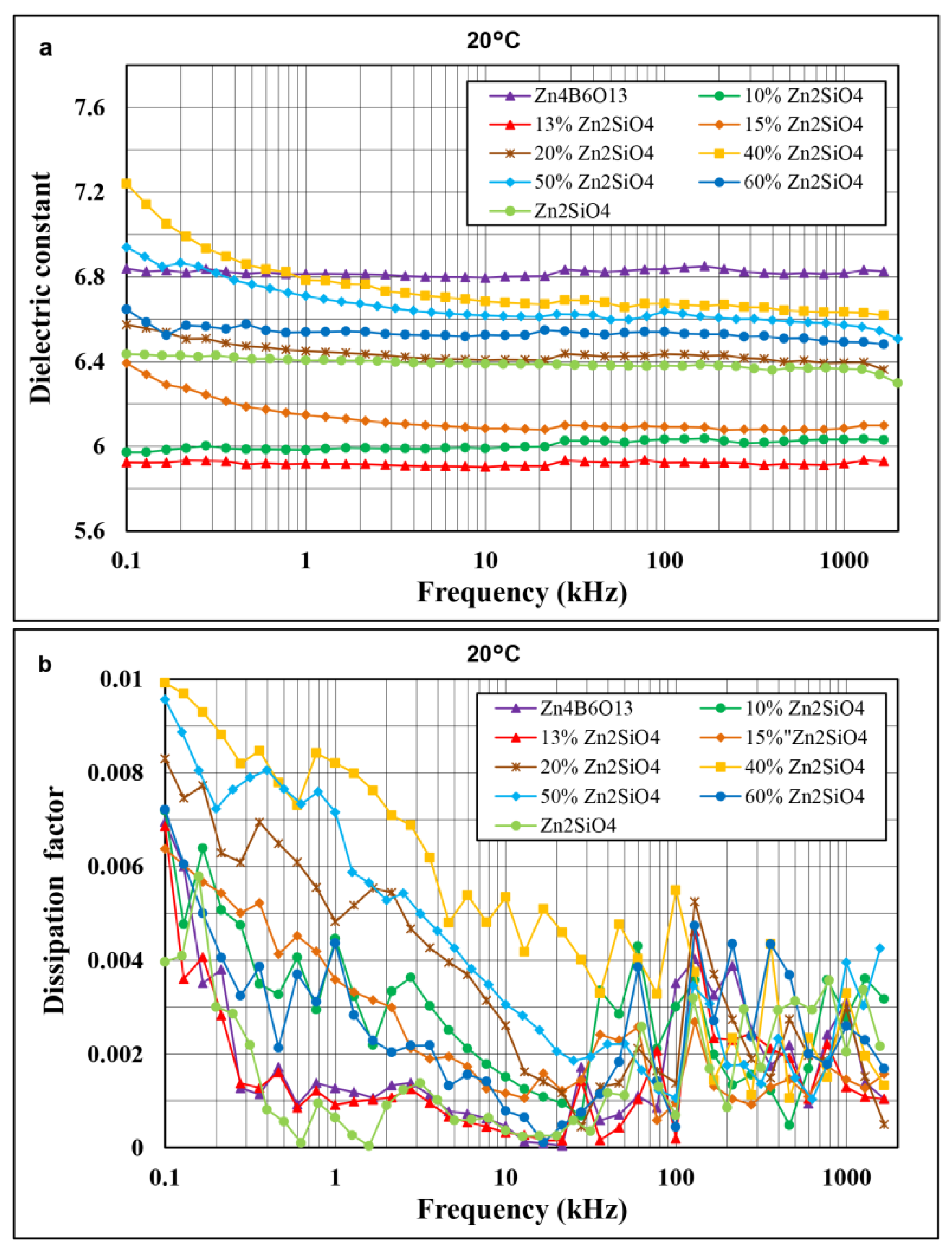
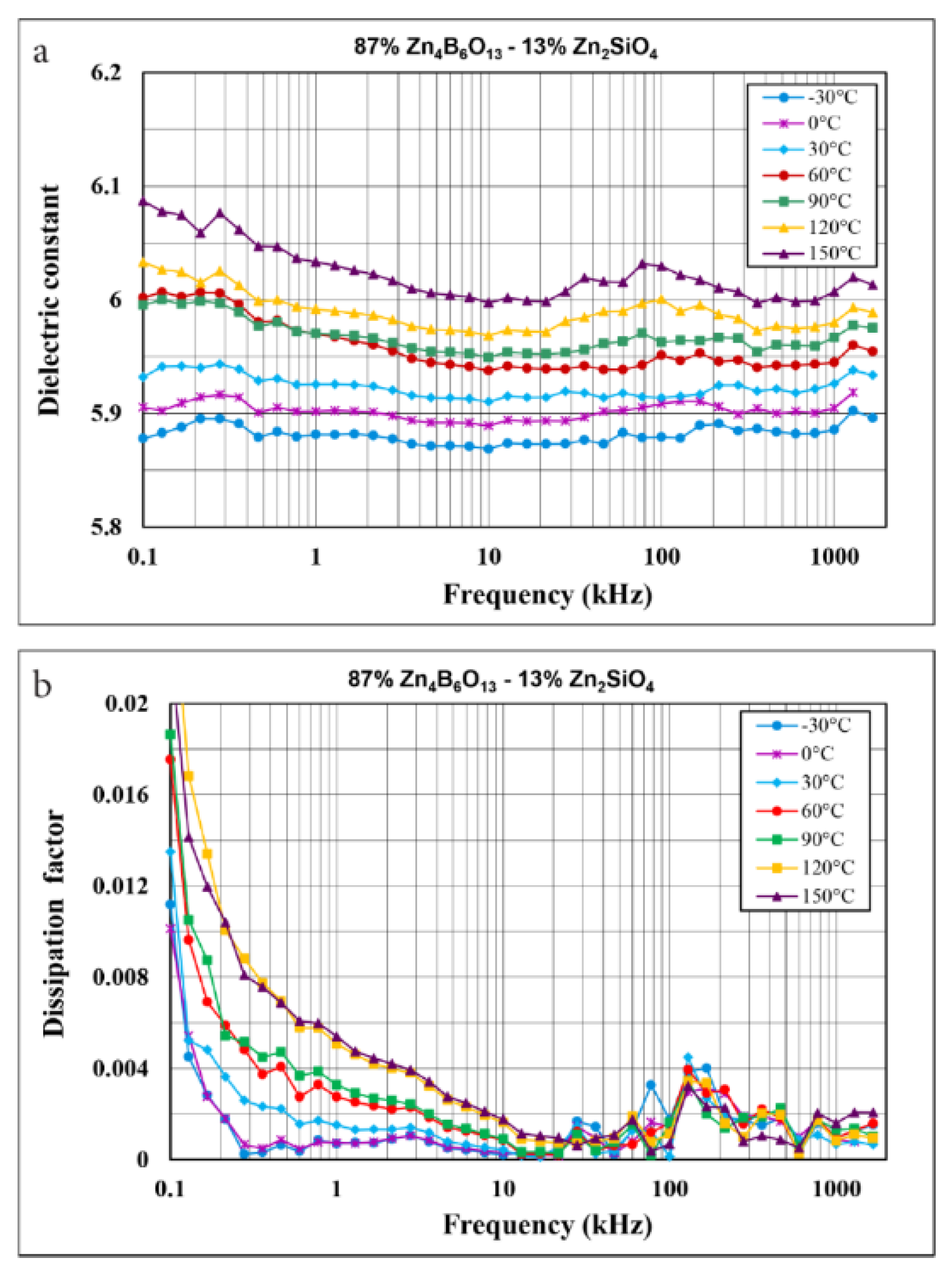
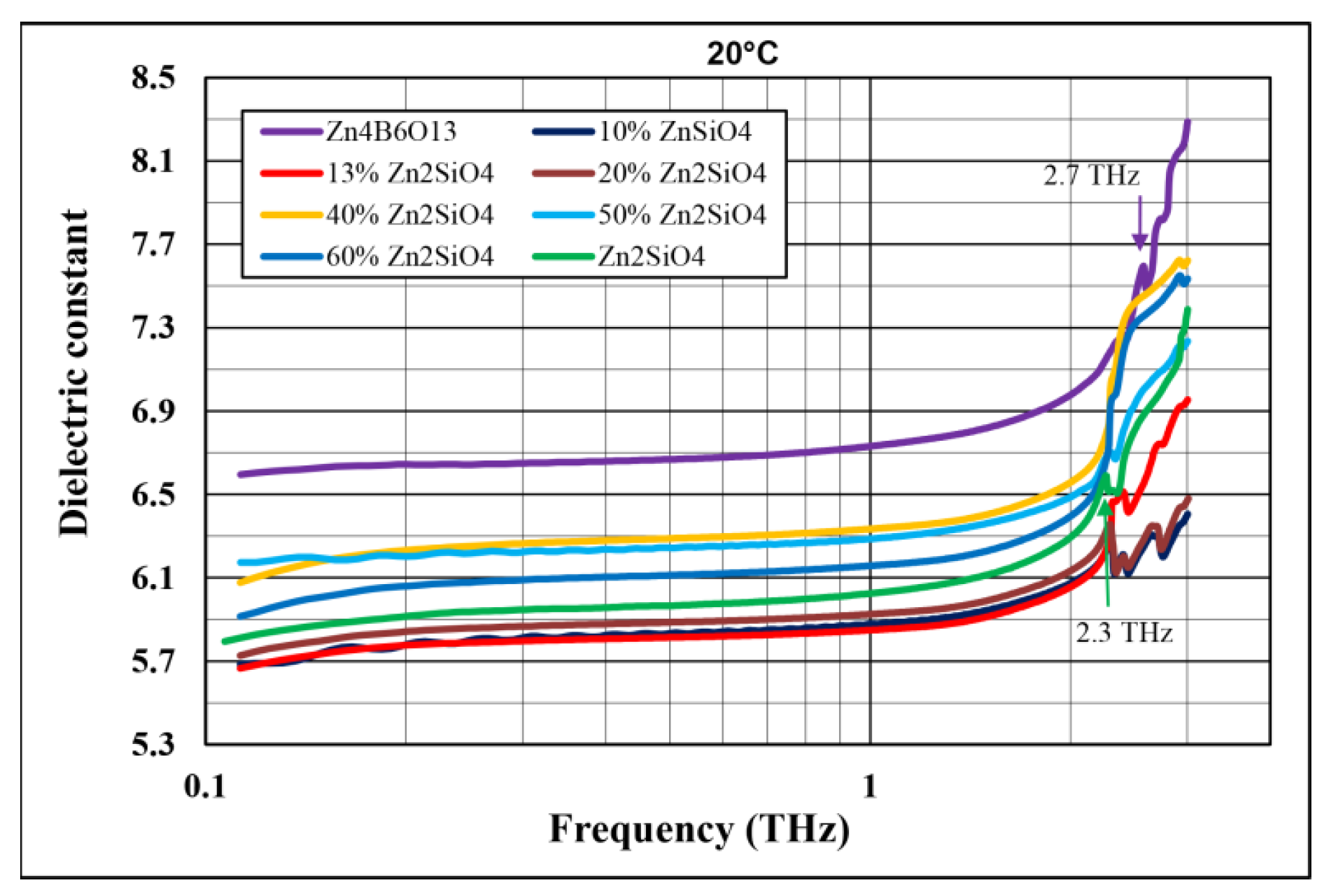
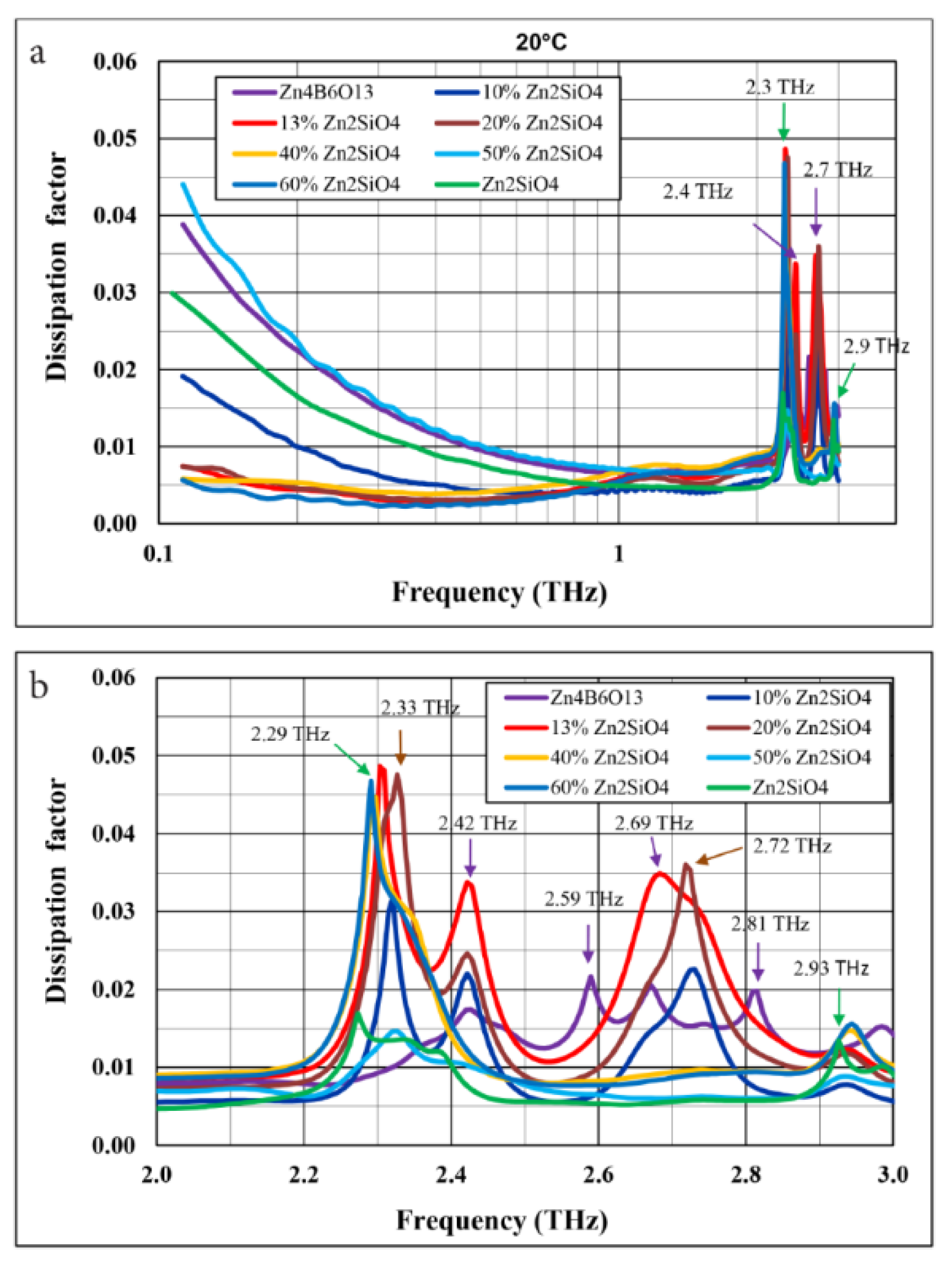
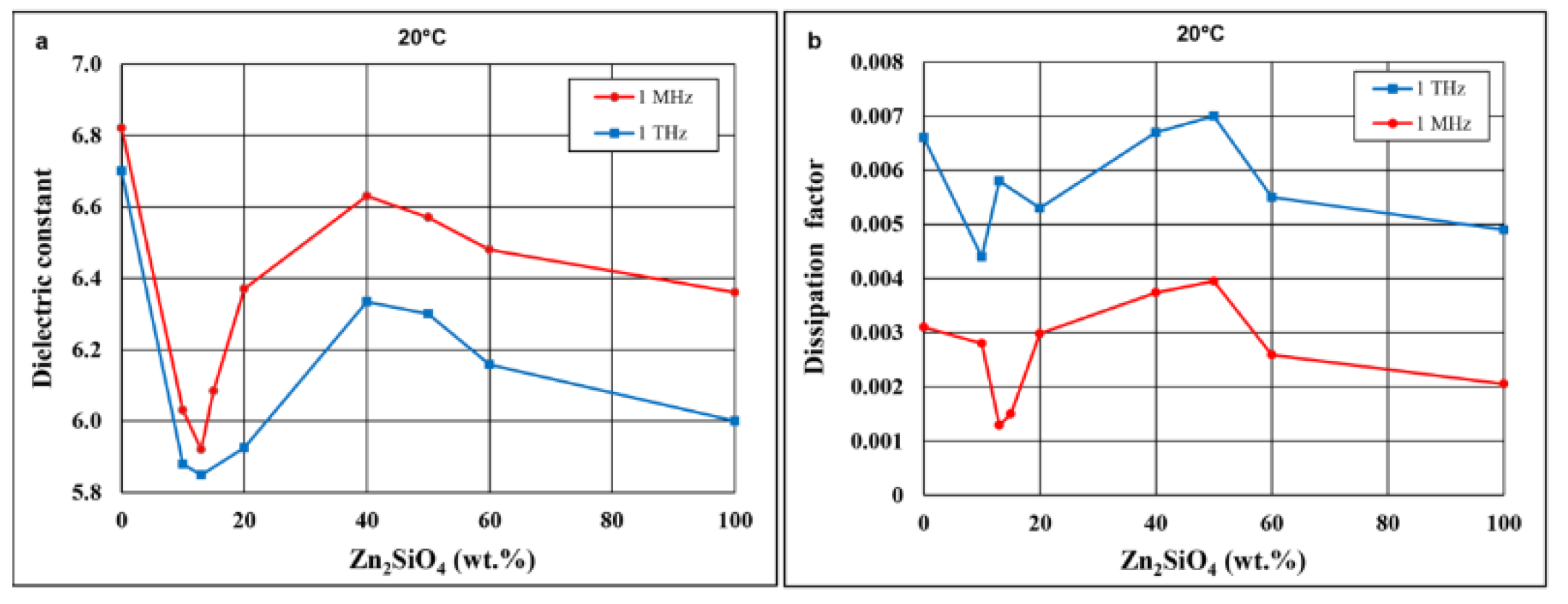
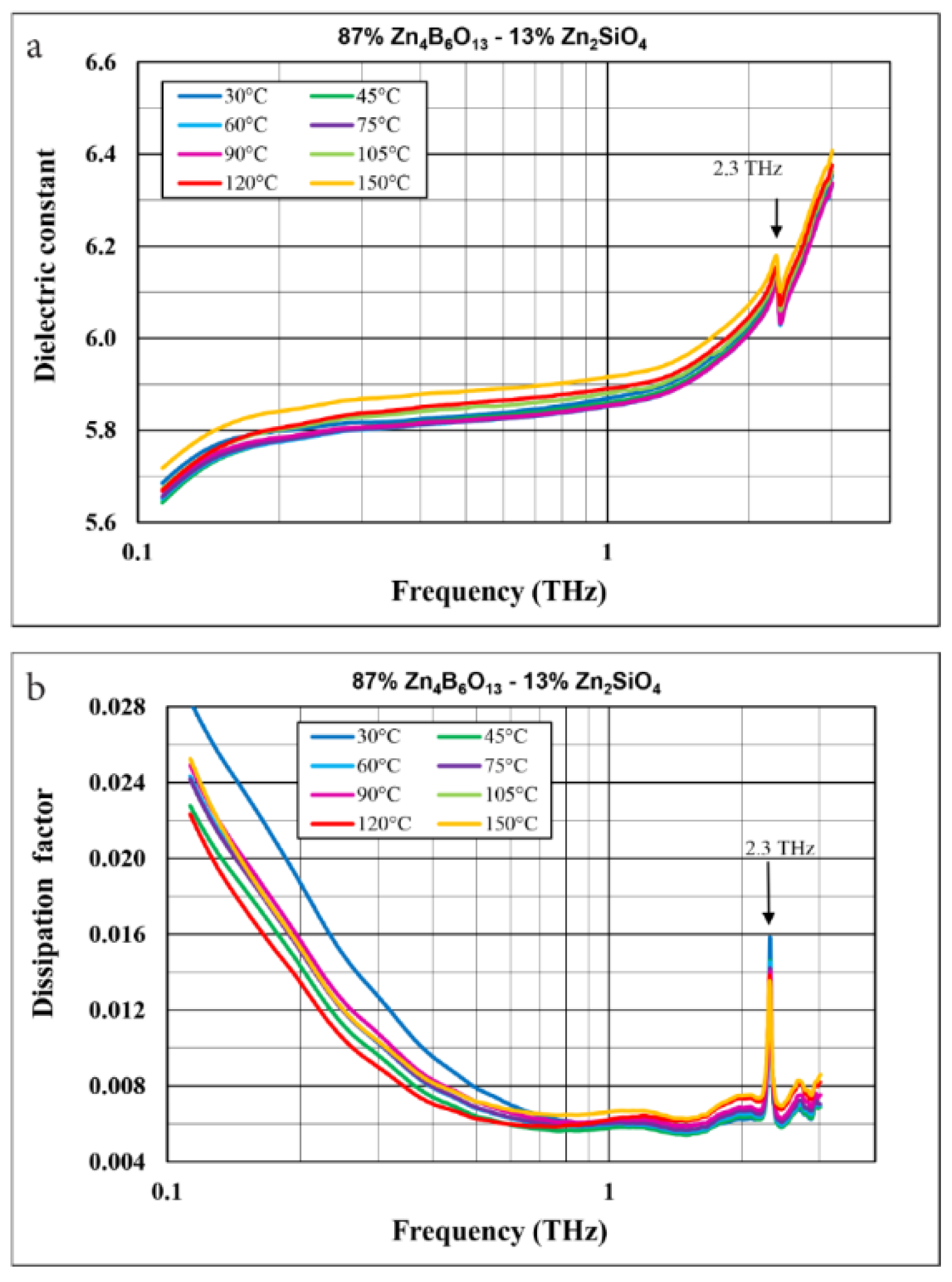

| Lattice Parameters | Zn2SiO4 Content (wt %) | |||||
|---|---|---|---|---|---|---|
| 10 | 13 | 15 | 20 | 40 | 60 | |
| “a” Zn4B6O13 (Å) | 7.4746 | 7.4749 | 7.4749 | 7.4748 | 7.4745 | 7.4743 |
| “a” Zn2SiO4 (Å) | 13.9326 | 13.9352 | 13.9350 | 13.9351 | 13.9303 | 13.9324 |
| “c” Zn2SiO4 (Å) | 9.3066 | 9.3066 | 9.3067 | 9.3081 | 9.3043 | 9.3060 |
| Element | at % | |||
|---|---|---|---|---|
| Point 1 | Point 2 | Point 3 | Point 4 | |
| B | 50.66 | 38.37 | 30.19 | 0.00 |
| O | 27.15 | 39.06 | 29.05 | 37.03 |
| Si | 1.05 | 3.72 | 5.32 | 19.11 |
| Zn | 21.15 | 18.85 | 35.44 | 43.86 |
Publisher’s Note: MDPI stays neutral with regard to jurisdictional claims in published maps and institutional affiliations. |
© 2021 by the authors. Licensee MDPI, Basel, Switzerland. This article is an open access article distributed under the terms and conditions of the Creative Commons Attribution (CC BY) license (http://creativecommons.org/licenses/by/4.0/).
Share and Cite
Szwagierczak, D.; Synkiewicz-Musialska, B.; Kulawik, J.; Pałka, N. LTCC and Bulk Zn4B6O13–Zn2SiO4 Composites for Submillimeter Wave Applications. Materials 2021, 14, 1014. https://doi.org/10.3390/ma14041014
Szwagierczak D, Synkiewicz-Musialska B, Kulawik J, Pałka N. LTCC and Bulk Zn4B6O13–Zn2SiO4 Composites for Submillimeter Wave Applications. Materials. 2021; 14(4):1014. https://doi.org/10.3390/ma14041014
Chicago/Turabian StyleSzwagierczak, Dorota, Beata Synkiewicz-Musialska, Jan Kulawik, and Norbert Pałka. 2021. "LTCC and Bulk Zn4B6O13–Zn2SiO4 Composites for Submillimeter Wave Applications" Materials 14, no. 4: 1014. https://doi.org/10.3390/ma14041014
APA StyleSzwagierczak, D., Synkiewicz-Musialska, B., Kulawik, J., & Pałka, N. (2021). LTCC and Bulk Zn4B6O13–Zn2SiO4 Composites for Submillimeter Wave Applications. Materials, 14(4), 1014. https://doi.org/10.3390/ma14041014







